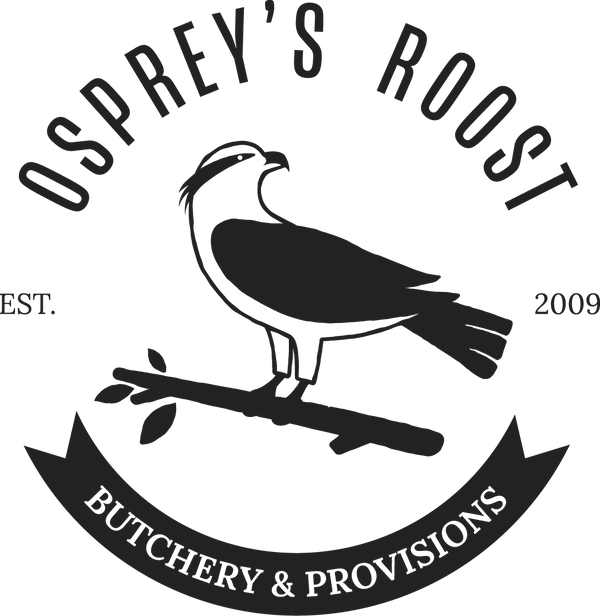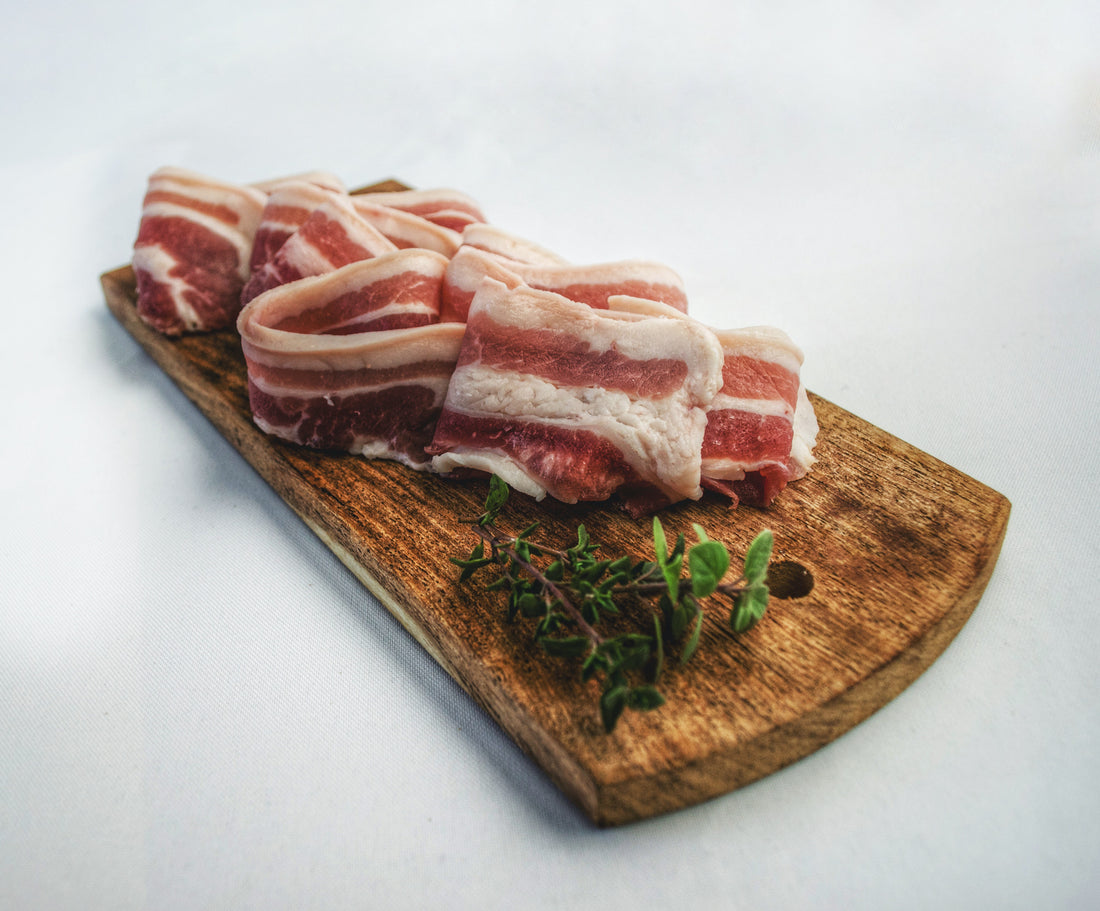All bacon is made with that classic combination of salt, meat and time. There are two main methods of making bacon – Dry Cured and wet cured. We use a dry cure method.
Dry curing has been used as a method of food preservation since prehistory. A dry cure uses salt to draw the water out of the cells in the meat, leaving the microbes that spoil meat without the resources they need to grow. Often, salted meats were smoked as well - it would tenderize the meat and create a hard surface that prevented bacteria from entering the meat while it was stored.
Today, the process of dry curing bacon at Getaway Farm has changed little. It all starts with salt and sugar, and of course high quality pork bellies from pasture raised pigs. Our certified Butchers remove the skin and trim away excess fat, then they carefully inspect the meat to make sure it meets our high standards.
We rub the pork bellies with a mixture of salt, sugar, and curing salt (which contains nitrites). Then they get moved to cold storage in our fridge for the next five days while they cure in the salt. Once a day, they get flipped over and the cure mixture rubbed back in to ensure they cure evenly.
| NITRATES
Nitrites are an important ingredient in bacon because they prevent botulism in the meat. Some products at the grocery store may be labelled as Nitrate Free, but this is a bit of a game. They contain Celery powder, which contains a large amount of natural nitrates. Usually there will be fine print on the label somewhere saying something like “Except for the naturally occurring nitrates in celery powder”. |
On the fifth day, the bellies are taken out of cold storage and we clean the extra salt and sugar off the bellies. By this point, the bellies have been cured and their moisture content is much lower – they lose over 20% of their starting weight
Then we chill the bellies for 24 hours to prepare them for slicing. Our famous Smoked Belly Bacon is sliced to just over 1/8th of an inch (or 3.5mm) – that’s about double the thickness of a slice of grocery store bacon. And speaking of grocery store bacon…
Most, if not all bacon in the grocery store is made using a wet cure method. As before, it begins with Pork Bellies. The bellies are loaded onto a conveyer belt system that runs them over automatic de-skinning knives, then they are hand checked by meat cutters as the bellies move down the production line.
The next step is a trip to the injection machine. The machine stabs the bellies hundreds of times with small needles, injecting a brine solution of water, salt, sodium erythorbate and sodium nitrate. Sometimes other ingredients are added, such as liquid smoke.
| LIQUID SMOKE It should be noted that liquid smoke is not a chemical solution created in a lab - it’s created by cooling down wood smoke and condensing it into a liquid. We still have some pretty strong feelings about using liquid smoke over real smoke, though. |
The bellies are then left in vat of brine or tumbled in a vacuum-sealed container, which opens cells further to the brine. The bellies are then cured. The length of the cure varies greatly - anywhere from 30 minutes to 7 days!
The next stage for the bellies is smoking. Depending on the brand, the wet-cured bellies can either be sent to a smoke booth, or simply drenched in liquid smoke.
As usual, you get what you pay for. More expensive bacon is usually smoked longer and uses better quality bellies, and cheap bacon uses low quality bellies with large amounts of chemicals to create that smoky flavor faster.
After smoking (or drenching), the bellies are chilled to make slicing easier. An automated slicer cuts the bacon to the desired thickness – usually 1/16th of an inch (or 1.5mm). Thick cut bacon is usually cut at twice that thickness, close to 1/8” (or 3.12mm). Yes, that means our regular bacon is thicker than what the grocery stores call thick-cut!
Since the wet-cure method lets the meat retain its water – and even adds more liquid – it doesn’t lose weight during production. Sadly, that means you’re paying for water: you pay for the weight of the added water, and then all that extra liquid gets cooked off in the frying pan.
That’s why grocery store bacon shrinks so much when you cook it! In comparison, we REMOVE liquid via the dry cure – that means you’re getting more meat by weight in our 454g packages, whereas the 375g packs from the grocery store will shrink down to even less meat when cooked.
All varieties of bacon offered by Getaway Farm are dry-cured, and we use local ingredients whenever possible: our Smoked Jowl Bacon is cured using maple sugar from Acadian Maple and our amazing Beer Bacon is made with local brews! And we’re such a fan of that salty sweet flavour that we’ve got four types of bacon for you to try:
Smoked Belly Bacon - our first and most popular bacon. Everything you ever wanted good bacon to be! Smoky, salty, and sweet - and it won’t shrink in the pan.
All varieties of bacon offered by Getaway Farm are dry-cured, and we use local ingredients whenever possible: our Smoked Jowl Bacon is cured using maple sugar from Acadian Maple and our amazing Beer Bacon is made with local brews! And we’re such a fan of that salty sweet flavour that we’ve got four types of bacon for you to try:
Smoked Belly Bacon - our first and most popular bacon. Everything you ever wanted good bacon to be! Smoky, salty, and sweet - and it won’t shrink in the pan.
English Bacon – the pork loin is cured using maple sugar, without being smoked. It has a higher meat to fat ratio than our Smoked Belly Bacon with a salty-sweet taste that will keep you coming back for more.
Cottage Bacon – smoked and cured pork shoulder cut a bit thicker than our regular bacon, it has all the smoky flavour of our famous Smoked Belly Bacon in a round shape that makes it perfect for putting on a burger. A thicker, meatier cut of bacon.
Beer Bacon – we take cured pork shoulder and let it marinade in beer from one of our favourite local microbreweries (the brand we use changes all the time). The saltiest of our bacon types, it tastes amazing in a breakfast sandwich, on a burger, or just served up for breakfast with free-range eggs!
Smoked Jowl Bacon – by far the richest flavour of all our bacon types, made from pork jowl cured with maple sugar. Each fatty slice of jowl bacon has an eye of smoky, tender meat. Cook at high heat for curls of bacon (perfect for bacon-wrapped scallops!) or at lower heat to render out lots of delicious bacon fat to cook your veggies in!

